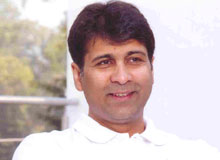These are exciting times for Bajaj Auto. On the last day of fiscal 2010-2011, the company rolled out the 125 cc Discover motorcycle. The new model is not just filling the gap in Bajaj Auto’s Discover range. (The Discover 100 was launched in July 2009 and the Discover 150 in May 2010.) The new Discover should help the company make further inroads into the market share of leader Hero Honda. Brand Discover sells around 120,000 units a month; the new model should push up this number to 150,000. Bajaj has 27% share of the motorcycle market while Hero Honda (which has severed its ties with Honda and will soon announce a new brand name and identity) still has more than 50%, led by the world’s largest-selling two-wheeler — Splendour. Bajaj Auto expects 20% growth in sales in 2011-2012.
Bajaj has acquired a 38% stake in Austrian bike maker KTM Power Sports and will be introducing products from its range in the Indian market. The first is likely to be the Duke 125 cc. Also on the cards are superbikes from its long-standing partnership with Kawasaki of Japan. (The U.S.-based Harley Davidson opened its first dealership outlet in the country last year.)
There has also been news that a Bajaj four-wheeler is in the works. “I have driven the prototype of this vehicle,” says Bajaj Auto managing director Rajiv Bajaj. Though he is unwilling to talk more about it, the indications are that it will be in the US$3,000 range and have a mileage of 30 km a liter (about 70 miles a gallon). It is based on the two- and three-wheeler platform and cost structure. A planned marketing tie-up with Renault-Nissan may fall by the wayside if the latter finds this product of the “frugal engineering” mindset not fitting with its image. But Rajiv Bajaj is prepared to go to market on his own.
All of this should help lift some weight off the 44-year-old Bajaj’s shoulders. He has been under pressure since he assumed the role of managing director in 2005 and even earlier when he was joint MD. He took the company into motorcycles while abandoning its mainstay – scooters. In the process, he lost leadership in the two-wheeler market to Hero Honda. He also decided to abandon the umbrella brand “Bajaj,” letting the productsbattle it out based on their own brand-names. The company – including his father and chairman Rahul Bajaj – was aghast. Analysts wrote off both Rajiv Bajaj and Bajaj Auto.
No longer. Market share is growing even as Hero Honda slips. And at the top of the agenda is profit share, which Bajaj says is more important to him than volumes. Last year, Rajiv Bajaj was one of the finalists for the Ernst & Young Entrepreneur of the Year award.
The laconic Bajaj, who has been avoiding the media for some years now, interacted with India Knowledge at Wharton in an email interview. An edited version follows:
India Knowledge at Wharton: You studied mechanical engineering at the University of Pune when many of your peers were going abroad. Within Bajaj Auto, you had to drive against tradition by moving out of scooters – the success story at Bajaj – and into motorcycles. What made you do things differently? Was it difficult for you to get accepted by the team at Bajaj Auto?
Rajiv Bajaj: There was nothing profound that guided my choices; I just pursued my interests, did the doable, worked with people I liked, and each opportunity opened the door to the next.
India Knowledge at Wharton: You have stepped out of the scooters market and are concentrating on motorcycles. But scooters are doing well again. Do you see this as a passing phase? Are you responding to consumer aspirations rather than the immediate marketplace?
Bajaj: Nobody knows what will happen in the future, but the past clearly tells us that less is more; those who do one thing well (such as motorcycles) have a far greater shot at success than those who try to do everything.
India Knowledge at Wharton: You have recently said that you will be launching a small car next year and the prototype is ready. Will this compete with the Nano in price? What volumes are you looking at?
Bajaj: Ours is a four-wheeler, not a car; it’s too soon for any details on price and volumes.
India Knowledge at Wharton: Moving from scooters to motorcycles was a natural progression as the country – hence your customers – grow richer. Is going from two-wheelers to automobiles also a natural progression? Do you see a day when Bajaj Auto could stop its manufacture of two-wheelers altogether?
Bajaj: Darwin said that it’s not the strongest or the most intelligent of the species that survive, but the ones that are most adaptive to change; Bajaj Auto must suitably adapt to the market’s evolution.
India Knowledge at Wharton: Within motorcycles, the sports segment is17% and growing. Is this another indication that motorcycles are moving from a means of transportation to an experience?
Bajaj: Yes, slowly but surely.
India Knowledge at Wharton: Do you see your company as being more focused on the rural markets? What changes are being witnessed there for your products?
Bajaj: We are focused on brands not geography. As buying power in rural areas grows in line with their buying aspirations, so does the potential for our “bigger and sportier” bikes.
India Knowledge at Wharton: You have substantial exports but mainly to developing economies. What are your plans on this front?
Bajaj: Our exports have grown over the past decade from being next to zero to now representing a quarter of our sales. I expect such growth to continue.
India Knowledge at Wharton: At different times you have looked at plans to set up units in Indonesia, Brazil, Nigeria and China. Why has there been no significant progress on these plans? Is export from India adequate to be a global player? Do you want — or need — to be a global player?
Bajaj: We have assembly facilities in many overseas markets including Indonesia and Nigeria. Being global means having one’s front end in all relevant global markets, not the back end. That should be wherever the quality-cost balance is best achieved for the particular brand.
India Knowledge at Wharton: China has 67% of the world motorcycles market. What is your strategy to cope with them? Why have they not been able to make any headway in India?
Bajaj: Most Chinese motorcycles are poor examples of strategy, quality and profits; that is why they are not in India or any similar evolved market, and we thus don’t need to cope with them.
India Knowledge at Wharton: What is the positioning of the Chinese manufacturers, the Japanese manufacturers and Bajaj globally?
Bajaj: In my view the actions of each suggest that the strategy of the Chinese is driven by volumes, that of the Japanese by quality, whereas Bajaj Auto’s is centered on brands.
India Knowledge at Wharton: You have increased your stake in Austrian bike-maker KTM Power Sports AG to 38%. Is this company going to lead your foray into developed markets?
Bajaj: It’s a case-to-case decision to be made from time to time.
India Knowledge at Wharton: You have recently said that you want your motorcycles to be sold under individual brand-names rather than bank on the Bajaj umbrella brand. That has caused a great deal of controversy and adverse comment. What is your reasoning?
Bajaj: Mother-umbrella-roof brands are, almost without exception, ineffective and especially so for B2C (business-to-consumer) businesses. This is a matter of fact not opinion that can be ascertained from studying any and all industries. Take the case of the more successful B2C businesses of the Tatas, perhaps India’s most famous such brand. Do you wear Titan or Tata Watches? Do you stay at the Taj or Tata hotels? Do you drink Himalaya or Tata water? Do you pay more for Tetley Tea or Tata Tea? Those who carry a different opinion do so, in my view, because:
· They have never built a successful new brand themselves in the face of world-class competition.
· They do not understand that a brand, first and foremost, is that which commands pricing power in the marketplace.
· They instead most often glorify the short-term sales stimulus that their favored approach provides, conveniently ignoring the longer-term depression of profits that it causes.
All around the world products sell, but brands profit. That’s why Bajaj Auto’s strategy is not product-led but brand-centered. That’s why while all our peers in the Indian auto industry typically deliver an EBITDA (earnings before interest, tax, depreciation and amortization) around 12%, we deliver about 50% more at over 20%. That’s why we are, in all probability, the world’s most profitable automaker.
The umbrella brand approach of most automakers is a leaky roof because thoughtful customers wonder about the [corporate] values of a mother [brand] whose children are so diverse. As [ad guru David] Ogilvy said, the customer is not a moron, she is your wife. Personally, I’m happy that some of our critics and competition disagree with our brand-centered strategy; this mindset of theirs is perhaps our greatest competitive edge. To summarize: Just as pretty actresses bathe with Lux, not Hindustan Unilever Ltd., cool guys ride a Pulsar, not the Rahul Bajaj Group.
India Knowledge at Wharton: The Bajaj Auto website says that your “current priority is the application of the scientific principles of homoeopathy to the task of building a brand-centered strategy at Bajaj Auto with the objective of achieving its vision of being one of the world’s leading motorcycle and small commercial vehicle manufacturers.” Would you explain the reference to homeopathy a bit?
Bajaj: Homeopathy is based on the concept of individualization where the doctor looks at the person and not just the problem that he might be having. I found the concept of individualization very applicable to business. Contrary to looking at things piecemeal, like the blind men and the elephant, I found that if one looks at things more holistically as homeopathy does, one is likely to achieve far deeper solutions and solutions that are sustainable over time.



